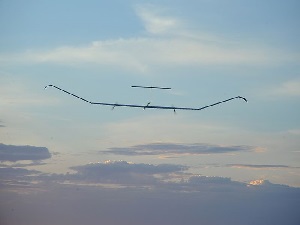



Date:09/08/18
 Airbus’ Zephyr high-altitude drone has logged a maiden flight of 26 days, the longest duration un-refuelled flight ever made.
Airbus’ Zephyr high-altitude drone has logged a maiden flight of 26 days, the longest duration un-refuelled flight ever made.
The solar-powered Zephyr S, which Airbus calls a High Altitude Pseudo-Satellite (HAPS), achieved the new world record after taking off on July 11 from Arizona, USA. The Zephyr S, which is the first production aircraft of the Zephyr program, flew for 25 days, 23 hours, and 57 minutes.
Airbus is still waiting for official recognition of the new world record from the Fédération Aéronautique Internationale. The previous record for the longest un-refuelled flight has been held by a Zephyr prototype since 2010 for 14 days.
Jana Rosenmann, head of unmanned aerial systems at Airbus, said, “This successful maiden flight represents a significant milestone in the Zephyr programme, adding a new stratospheric flight endurance record which we hope will be formalised very shortly.
“We will in the coming days check all engineering data and outputs and start the preparation of additional flights planned for the second half of this year from our new operating site at the Wyndham airfield in Western Australia.”
Rosemmann has previously said the drone could fly continuously for up to 100 days.
Airbus said the test flight proved the system capabilities and achieved all of the flight’s engineering objectives.
Zephyr runs exclusively on solar power, above the weather and conventional air traffic, at altitudes of up to 59,000ft.
The Zephyr S is equipped with cameras but has been designed to use different payloads. Potential civil applications for the Zephyr include remote sensing, such as providing imagery and live video streaming and the provision of broadband internet connectivity.
For defence, the Zephyr can be fitted out to provide a “connectivity backbone” for military operations and could also be used for surveillance activities, said Airbus. “It’s fine to be flying but we also need to offer a capability as well,” said Rosenmann.
Two versions of the drone are being developed. The Zephyr S is configured with a single tail, while the Zephyr T will have a twin tail and be able to carry a heavier payload.
Zephyr drone breaks endurance record during maiden test flight
 Airbus’ Zephyr high-altitude drone has logged a maiden flight of 26 days, the longest duration un-refuelled flight ever made.
Airbus’ Zephyr high-altitude drone has logged a maiden flight of 26 days, the longest duration un-refuelled flight ever made.The solar-powered Zephyr S, which Airbus calls a High Altitude Pseudo-Satellite (HAPS), achieved the new world record after taking off on July 11 from Arizona, USA. The Zephyr S, which is the first production aircraft of the Zephyr program, flew for 25 days, 23 hours, and 57 minutes.
Airbus is still waiting for official recognition of the new world record from the Fédération Aéronautique Internationale. The previous record for the longest un-refuelled flight has been held by a Zephyr prototype since 2010 for 14 days.
Jana Rosenmann, head of unmanned aerial systems at Airbus, said, “This successful maiden flight represents a significant milestone in the Zephyr programme, adding a new stratospheric flight endurance record which we hope will be formalised very shortly.
“We will in the coming days check all engineering data and outputs and start the preparation of additional flights planned for the second half of this year from our new operating site at the Wyndham airfield in Western Australia.”
Rosemmann has previously said the drone could fly continuously for up to 100 days.
Airbus said the test flight proved the system capabilities and achieved all of the flight’s engineering objectives.
Zephyr runs exclusively on solar power, above the weather and conventional air traffic, at altitudes of up to 59,000ft.
The Zephyr S is equipped with cameras but has been designed to use different payloads. Potential civil applications for the Zephyr include remote sensing, such as providing imagery and live video streaming and the provision of broadband internet connectivity.
For defence, the Zephyr can be fitted out to provide a “connectivity backbone” for military operations and could also be used for surveillance activities, said Airbus. “It’s fine to be flying but we also need to offer a capability as well,” said Rosenmann.
Two versions of the drone are being developed. The Zephyr S is configured with a single tail, while the Zephyr T will have a twin tail and be able to carry a heavier payload.
Views: 751
©ictnews.az. All rights reserved.Similar news
- The mobile sector continues its lead
- Facebook counted 600 million active users
- Cell phone testing laboratory is planned to be built in Azerbaijan
- Tablets and riders outfitted quickly with 3G/4G modems
- The number of digital TV channels will double to 24 units
- Tax proposal in China gets massive online feedback
- Malaysia to implement biometric system at all entry points
- Korea to build Green Technology Centre
- Cisco Poised to Help China Keep an Eye on Its Citizens
- 3G speed in Azerbaijan is higher than in UK
- Government of Canada Announces Investment in Green Innovation for Canada
- Electric cars in Azerbaijan
- Dominican Republic Govt Issues Cashless Benefits
- Spain raises €1.65bn from spectrum auction
- Camden Council boosts mobile security





















